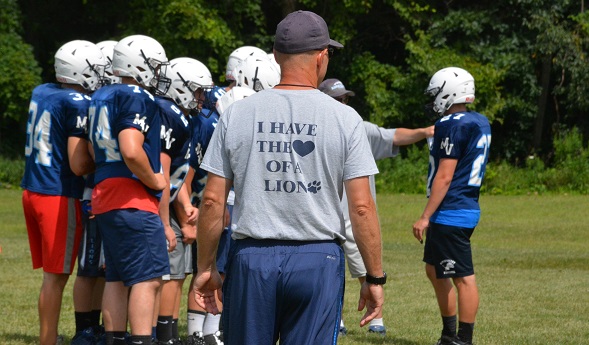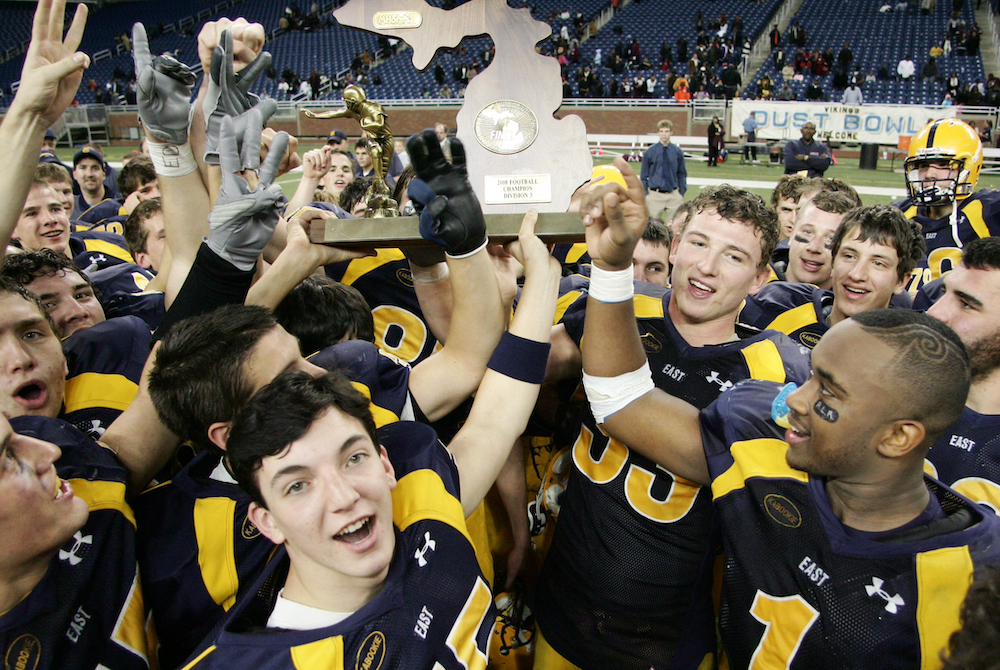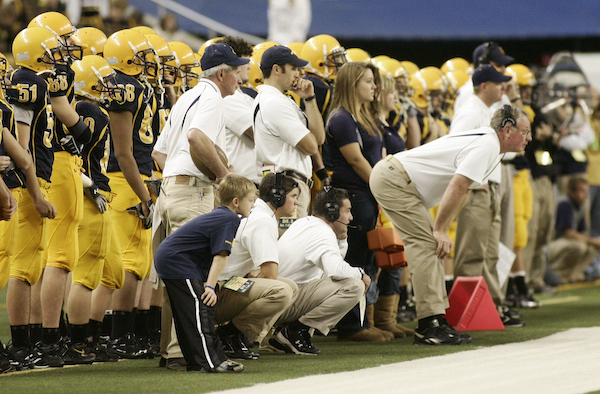
Community Backs Maple Valley's Surge
August 13, 2015
By Geoff Kimmerly
Second Half editor
VERMONTVILLE – It’s almost with disbelief that first-year coach Marty Martin considers the recent history of his once-feared Maple Valley football program.
“It’s been nine years since we’ve had a winning season,” said Martin, who was part of the team’s first outright league title as a senior in 1983. “It gives me goose bumps to think about that.”
But he’s had similar reactions to the outpouring of neighborly support his program has received as it works to start a revival.
Members of the community, made up of about 3,500 residents, have donated $46,000 to go with $15,000 allocated by Maple Valley's school board for the purchase of new equipment that will be used this fall. Some was necessary to fit an influx of players, but the additional funds allowed the program to update and replace some of its older gear as well.
Confidence. Comfort. Swagger. The players anticipate a little more of all three when Maple Valley opens against Fowler on Aug. 28 outfitted in new uniforms over new shoulder pads and with new helmets topping them off.
Those good feelings come with heightened expectations, of course – which are welcomed by a program that made the playoffs seven of eight seasons and played in an MHSAA Final during the stretch preceding its recent struggles.
“It’s coming back. You can feel it,” Maple Valley senior Isiah Garn said. “On the field, the coaches are expecting more … not letting you short yourself. And the community is jumping in on us; there is so much support there. Everyone wants us to be a success again.”
Dressed to impress
Martin is deeply rooted in the school. His father was a 1953 graduate of the former Vermontville High and started middle school basketball and football and summer league baseball programs in the community before also coaching at the new Maple Valley High School after it opened in 1963. Marty played football for Dan Watson on the Maple Valley varsity after playing junior varsity for Guenther Mittelstaedt, who followed Watson and led the varsity to a 173-70 record over 24 seasons through 2008.
After playing two years of baseball in junior college, Martin came back to the community to work as a postal worker and coach, and under Mittelstaedt helped the Lions to their first playoff appearance, in 1987. He remained on Mittelstaedt’s staff through 2000, then coached a year at Battle Creek St. Philip, four years at Battle Creek Lakeview where he also taught after earning his degree, then with Mittelstaedt again for two years at Lakeview in Montcalm County.
 Martin returned to teach at Maple Valley a year ago and became only the third varsity football coach in 30 years during this offseason.
Martin returned to teach at Maple Valley a year ago and became only the third varsity football coach in 30 years during this offseason.
Maple Valley is a little different place than even a decade ago. The school’s enrollment briefly passed 500 during the 2007-08 school year but fell to just over 370 students as of this spring – and Martin said there are fewer than 70 seniors in this fall’s class. The community’s economics also have changed, he added, with fewer families farming or enjoying jobs with General Motors in Lansing or Kellogg in Battle Creek.
Near the top of his to-do list was simply getting more players back into the program. Maple Valley had 40 last year, which at least worked for the amount of equipment the school had in stock.
But 69 students signed up to play this fall and 54 ended up at practice this week – good news, except for the helmet supply.
In addition to new helmets to outfit the new players, Martin also surmised eight more would need to be replaced at the end of this season, followed by 12 more needed after 2016 and 13 after 2017.
Instead, Martin began investigating if his program could get a better price by replacing the entire supply in bulk. After considering two helmets, he worked with his Riddell representative to get a deal on the helmets that included discounts on shoulder and girdle pads as well. The school board responded with its contribution – and then the community came on strong to help the rest of the way.
Martin was called out of class one day to receive a $5,000 check. Then came $1,500 from one family and $3,500 from another. He was at a graduation open house this spring when someone placed a $1,000 check in front of him. Longtime residents, some retired, gave $100; some who had graduated from Vermontville High or the other former school in Nashville, donated a few hundred as well.
Martin’s team spent parts of the summer (and will this Saturday as well) providing muscle to local service projects, but he’s never asked the community for financial help for the program. It just made sense to provide, said 1992 grad and former player and assistant coach Paul Adrianson, whose local business Hickey Electric was among the first to contribute.
“We want people to see the game of football doesn’t just necessarily survive. We think it can thrive if you put safety first or good fundamental education on it,” Adrianson said. “It can be a great sport for our future. … We really feel that if we get all behind and lead as a district and doing safety first, we think that’s going to set a positive trend for the game of football.”
Safety first
Maple Valley is one of 70 high schools statewide taking part in a pilot sideline concussion testing program sponsored this school year by the MHSAA. The Lions will work with XLNTbrain Sport, which incorporates baseline testing done at the start of the season to assist in return-to-play decisions after possible head injuries at practices and during games.
In addition, the Riddell SpeedFlex helmets Maple Valley purchased include the InSite Impact Response System, a series of sensors that alert sideline staff after a player’s helmet sustains what is considered a significant impact. That player will then be evaluated by training staff; Maple Valley also has a trainer this fall for the first time in 15 years, Martin said.
 “That was our initial thing. We want our kids to be the safest kids,” Martin said. “We want to be one of those leaders; we want to get this district, this community, out front so everyone in the state of Michigan and the United States knows in this area that people care about their kids to the extent they’re willing to invest $27,000 in purchasing helmets.”
“That was our initial thing. We want our kids to be the safest kids,” Martin said. “We want to be one of those leaders; we want to get this district, this community, out front so everyone in the state of Michigan and the United States knows in this area that people care about their kids to the extent they’re willing to invest $27,000 in purchasing helmets.”
The helmets require reconditioning each offseason and new batteries for the InSite sensors – to the tune of $2,200. But another donor stepped in with $22,000 – enough to keep the new helmets ready to wear for a decade.
“This community identifies with this football team,” Martin said. “So they were ready for a change, and they were looking for this opportunity. I’m very blessed and humbled to think they’re showing trust in my leadership and my coaching staff and in the fact we can turn things around.”
His players have heard the stories of successes past, some before they were born. They’ll try to extend the “look good, feel good” cliché into their play on the field this fall as they work to write a restart into Maple Valley’s winning history that goes with the other renovation projects that are popping up at the school and on its grounds.
“I think there’s going to be tons of people coming out,” senior Brock Weiler said. “It’s the new coach, everything getting re-done in the school. I think the pride’s coming back.”
PHOTOS: (Top) Maple Valley huddles during offensive drills at Wednesday afternoon’s practice. (Middle) Coach Marty Martin leads the Lions through agility work. (Below) Maple Valley will wear new helmets this fall thanks in part to community donations.

EGR 5-Year Title Run Remains Awe-Inspiring, Product of More Than Talent Alone
By
Steve Vedder
Special for MHSAA.com
November 25, 2022
It was Peter Stuursma's first year at East Grand Rapids and while the wolves weren't necessarily knocking at the door, they were definitely on the prowl.
The tradition-rich Pioneers football team had slumped to an uncharacteristic 3-6 record in Stuursma's first season as varsity head coach in 2000, and there were subtle signs a community used to winning was growing restless with the program's direction.
That's when Stuursma bumped into one of his players coming out of the weight room, and the two had a quick conversation which he clearly remembers 22 years later.
"It was this senior offensive lineman and all he said was, 'Don't worry about it Coach, it's not going to happen again. We got this,’" Stuursma said. "We had just gone 3-6, and I'm wondering how we're going to get this going and that they might get rid of me. You never underestimate what people can do."
East Grand Rapids, under legendary coach George Barcheski, had been the dominant football program in West Michigan with 28 winning seasons over 29 from 1970-99, and 38 victories in 39 games from 1993-95, along with Class B championships in 1976 and 1983. After Stuursma replaced the retiring Barcheski,, some in the community were expecting more of the same when it came to success.
Those fans never dreamed what they would see as the Pioneers promptly pieced together arguably the greatest decade-long stretch in Michigan high school football history – and without doubt one of the most incredible five-year runs of dominance.
Even that optimistic offensive lineman couldn't have imagined a remarkable 126-7 record over the next 11 years, a 40-3 MHSAA Tournament mark and seven Finals championships. Five of those titles (2006-10) came in a row, a feat accomplished just three times in the now 46-year history of the playoffs.
 The five straight championships were part of an amazing era that Stuursma and his players say has not diminished with time. They recall no single factor explained going 67-3 overall over those five seasons. There was talent, obviously, but coaching, tradition, confidence and strength of community all played vital parts. There were Thanksgiving practices attended by hundreds of former football alumni, dedicated fan support that included playing before more than 30,000 fans at least twice at Ford Field, and a program-wide attitude that, while some may call it a cliché, proved that success did indeed breed success.
The five straight championships were part of an amazing era that Stuursma and his players say has not diminished with time. They recall no single factor explained going 67-3 overall over those five seasons. There was talent, obviously, but coaching, tradition, confidence and strength of community all played vital parts. There were Thanksgiving practices attended by hundreds of former football alumni, dedicated fan support that included playing before more than 30,000 fans at least twice at Ford Field, and a program-wide attitude that, while some may call it a cliché, proved that success did indeed breed success.
"I'm in awe of the scope of things," said Stuursma, whose team used back-to-back Division 3 championships in 2002-03 as a springboard to later success. "Because we had won a couple times before it just started to feel normal. We had such support the community used to think Thanksgiving break ended at Ford Field."
EGR teams would find all kinds of ways to win during the five-year title stretch. The 2009 team, for instance, barreled through its first four playoff opponents by a combined score of 164-29 until a 24-21 win over Orchard Lake St. Mary’s in the Final. The 2010 team had to win three playoff games by eight points or fewer to finish off its perfect 14-0 record. And then there was the wild 46-39 five-overtime win over St. Mary's in the 2007 Final during which the Pioneers had to score on all five possessions in overtime to outlast the Eaglets.
While teams always seemed to find ways to get the victory, former players remember what it was like to be part of a seemingly endless tradition of success on the football field.
"One of the things that was so special about East Grand Rapids were the expectations," said Luke Glendening, a running back on the 2006 team who has gone on to a long NHL career with the Detroit Red Wings and Dallas Stars. "During the game I'd look around and see guys who had played here a long time ago. I viewed it as a privilege to have the opportunity to play before the alumni and community."
Quarterback Ryan Elble, who completed a combined 34 passes for 483 yards and seven touchdowns during the 2008 and 2009 Finals, also used the word "honored" to describe his high school experience.
"The culture was to win. Coach Stuursma made it fun, and it always seemed to take shape on the field," said Elble, who went on to play baseball at Miami (Ohio) "I think each team had different skill sets, but at the end of the day it was our culture and putting in the work to spend Thanksgiving weekend at Ford Field."
The players point to that winning culture over talent. Elble said he played with only one eventual Division I college player in linebacker/running back Trent Voss, who went on to Toledo. Nobody wins without talent, of course, but they point to many other factors as being just as critical. Because EGR coaches would always work juniors into the lineup, Stuursma said the program faced only one major rebuild, in 2007. That team wound up 13-1 and the second of those five straight champions.
 "We had some incredible players," said Stuursma, who left EGR in 2016 to lead Hope College to two Michigan Intercollegiate Athletic Association titles, three second-place finishes and a 46-15 overall record over his seven seasons. "We returned only two starters (in 2007), but we still had good guys who wanted to win."
"We had some incredible players," said Stuursma, who left EGR in 2016 to lead Hope College to two Michigan Intercollegiate Athletic Association titles, three second-place finishes and a 46-15 overall record over his seven seasons. "We returned only two starters (in 2007), but we still had good guys who wanted to win."
The players say the culture started with Barcheski and the program's tradition. As Hope College's coach, Stuursma said there’s a similar common thread among schools he sees on recruiting visits: a winning tradition that, in Stuursma's words "screams excellence," from every corner of the building. He sees it the minute he walks into some schools, and East Grand Rapids had the same culture before he arrived. The past players say it played a major part in their careers.
That tradition didn't start with the five straight titles, said former quarterback Kyle Cunningham, who played on the 2002-03 teams and went 46-0 over four years from his freshman to senior seasons. Those two championship teams’ most recognizable player was running back Kevin Grady, who still holds multiple MHSAA records including for career rush yardage and went on to play at University of Michigan.
"We worked hard and had a lot of pride," he said. "I remember watching film of earlier teams, and I remember hoping our team could stand up the same way."
While the players point to tradition and community, Ryan Blair, a tight end/defensive tackle on the 2006-08 champion clubs, said talent remained critical – but EGR was outmanned physically in some of those title games. That's when camaraderie and the confidence that someone was going to make a key play took over. The Pioneers' remarkable run was teeming with such plays.
"Certainly we were never one of the biggest teams there, we never had a big size advantage in any game," he said. "But we had this camaraderie on every team. We had guys who really liked playing with each other. When things got tight we stuck together, and we'd fight to the fourth quarter or beyond."
Despite the long odds of winning a single state title let alone repeating, Stuursma believes there could be a team one day which wins six straight. That team will have the same characteristics of those EGR teams – the talent, coaching, tradition and fortune of catching timely breaks – but it can be done, he said.
"Absolutely," Stuursma said. "The only record I can think of that won't be broken is Wayne Gretzky's (NHL) scoring record. It will take a lot, but records are made to be broken. I think high school football is on the upswing and there would have to be an emphasis on winning. You would have to have a good path to get there, but I can see someone getting six one day."
PHOTOS (Top) East Grand Rapids celebrates its third-straight Division 3 championship win in 2008. (Middle) Pioneers converge on an Orchard Lake St. Mary’s ball carrier during the 2007 five-overtime title decider. (Below) EGR coach Peter Stuursma, kneeling center, monitors the action during the 2010 championship game.

